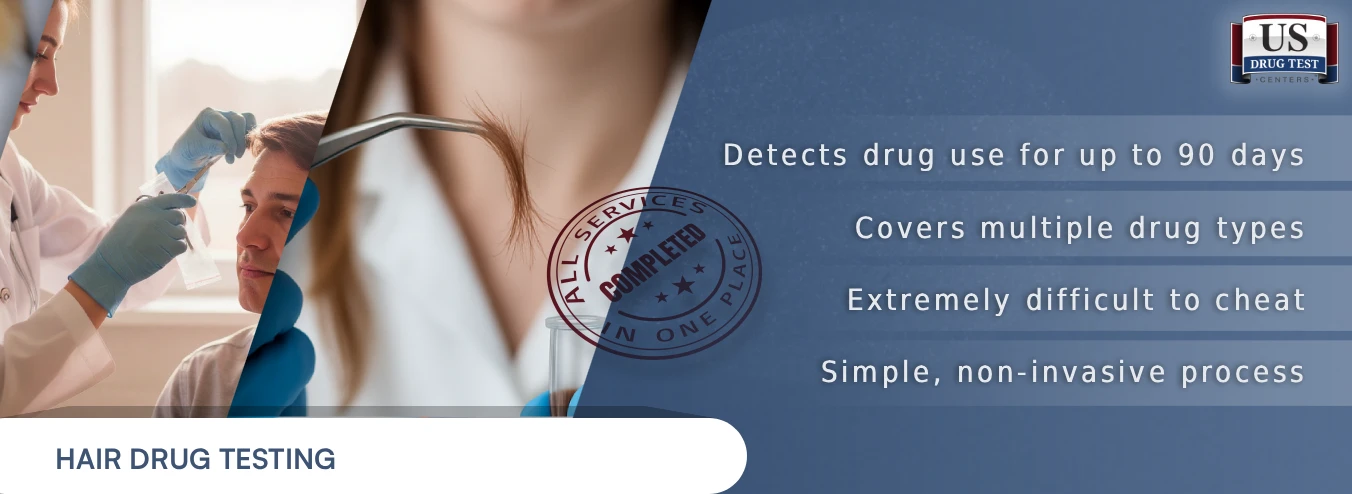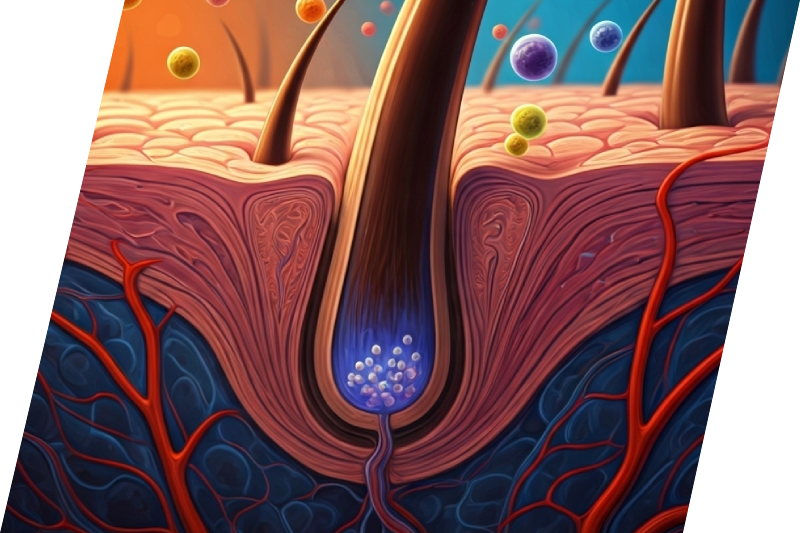
Last Updated: December 4, 2023
Have you been searching "hair follicle drug test near me" online? What is a hair follicle drug test, exactly?
Hair drug testing was first adopted by employers as the "executive level" method for employment drug testing. To this day, hair drug testing has proven its effectiveness and continues to play a vital role in ensuring security and safety within our nation’s workplaces. It's a bulletproof way to keep drug use at bay.
Hair follicle drug testing presents many advantages over other types of drug testing. However, it's essential to recognize its strengths and limitations.
US Drug Test Centers is your go-to provider for hair drug testing in all areas of the United States, for both individuals and employers. Same-day service is available with a three- to four-business-day turnaround for the results of hair drug testing.
If you need hair drug testing, we can help. US Drug Test Centers has customer service representatives standing by to take your order. Call 866-566-0261 or order your test online today!
First, let's talk about how drugs even end up in a hair sample.

After someone engages in drug use, the substances get metabolized. Then, the drug metabolites are absorbed into the user’s bloodstream. Humans have millions of hair follicles throughout the head and body. And each hair follicle has a blood vessel that feeds the growth of the hair strand.
The drug metabolites, after use, are carried from the blood into the hair shaft. Thanks to these drug metabolites, traces of illegal drugs can then be detected within the length of the hair strand using a hair follicle drug test.
This is how a hair follicle test can detect drugs! Drug use sends the illicit drugs into the blood and, eventually, the hair shaft.

Hair follicle drug testing is a quick and pressure-free experience.
How much hair does the donor need to provide hair samples?
Hair testing requires collecting a hair sample from anywhere on the body, as long as it's at least 1.5 inches in length. The hair sample cannot be provided from a brush or another unverifiable source. It must come directly from the donor.
For the drug use analysis to be effective, the collector will obtain, under direct observation, a 100-milligram sample of hair (approximately 90 to 120 strands) cut with scissors, preferably at the crown of the head. The hair strands are cut from as close to the scalp as possible. The collector can remove hairs from different spots on the head to avoid creating a bald spot.
For donors with very little or no head hair, the collector might use body hair, as deemed appropriate, for the hair test instead.
The collector will then secure the hair-strand sample in foil, complete the chain of custody documentation process, and prepare the specimen for shipment to a testing laboratory to screen for drug use.


Objective Testing That is Fully Supervised
Since hair samples are obtained under direct observation, in full view of the collector, the process nearly eliminates the likelihood of sample adulteration, specimen substitution, and false-positive results.
For this reason, a hair drug test is nearly impossible to cheat. Even if a donor uses certain shampoos or products that claim to cleanse hair follicles and help to beat the test, these products are unlikely to remove the drug metabolites from within the hair strand.
As a funny twist to cheating attempts, hair washing helps remove external contaminants, benefiting the hair testing process and making drug use even more detectable.


The Hair Follicle Drug Test Offers Superior Detection Time
When employers consider the different employment drug test methods available, they should focus on what they are trying to accomplish.
Do you want to detect long-term patterns of drug abuse in your employees? Do you prefer to collect hair samples instead of urine because hair samples are harder to cheat when it comes to detecting drug use?
Very often, many employers and other individuals end up choosing hair drug testing due to its unparalleled detection window.


Better Detection Window than Other Drug Tests
Employment drug testing methods are not all the same. They each have different detection levels (laboratory cutoff levels) and detection times — meaning how long after drug use has stopped the substance can be detected in a sample.
The window of detection is critical. It includes how soon after someone uses a drug and how long after they stop using it the drug can be found.
Hair drug test results offer a longer lookback window than a urine drug test.
In other words, hair drug testing provides the most prolonged detection period when screening for illicit drug use or prescription medication misuse compared to urine drug tests, blood tests, a sweat sample, or oral fluid (saliva) drug testing.
Testing via a hair sample will be able to detect a pattern of repeated drug use from approximately a week after the last use up to several months after the last use (one week to 90+ days).
Unlike a urine drug test, hair drug tests may not be useful for monitoring compliance regularly because they cannot discriminate between recent drug use and use that occurred months earlier.
Popular for detecting long-term drug use, hair drug tests should not be utilized to detect recent drug use, as this method is unable to detect single use within the last three to seven days.
Hair follicle drug tests are slightly more expensive than other testing methods, like urine tests.
Unlike urine tests, there is no "instant"/point-of-collection (POCT) or overnight testing option available for the hair follicle test. All hair drug tests require laboratory analysis.
The turnaround time for laboratory test results is longer due to the extensive analysis process.
Have you been asking, "Where is there hair follicle testing near me?" Hair drug testing is available from US Drug Test Centers with laboratory testing from Quest Diagnostics, Labcorp, US Drug Testing Labs, and Psychemedics.
Multiple hair follicle drug test panels are available, including:
Amphetamines (methamphetamine, ecstasy, MDMA, and MDA), cocaine, opi (codeine, morphine, and heroin), phencyclidine (PCP), and marijuana.
Learn More →Amphetamines, cocaine, phencyclidine (PCP), marijuana, and opi (codeine, morphine, heroin, hydrocodone, hydromorphone, oxycodone, and oxymorphone).
Learn More →Cocaine, marijuana, phencyclidine (PCP), amphetamines, benzodiazepines, barbiturates, methadone, propoxyphene, and opi (codeine, morphine, heroin, hydrocodone, hydromorphone, oxycodone, and oxymorphone).
Learn More →Cocaine, marijuana, phencyclidine (PCP), amphetamines, benzodiazepines, barbiturates, methadone, propoxyphene, opi (codeine, morphine, heroin, hydrocodone, hydromorphone, oxymorphone), meperidine, tramadol, and oxycodone.
Learn More →Cocaine, marijuana (THC, cannabinoids), phencyclidine (PCP u2013 angel dust), amphetamines (methamphetamines, also known as crystal meth), opi (heroin, codeine, morphine, hydrocodone, hydromorphone, Oxycodone), propoxyphene, methadone, benzodiazepines (such as Xanax), barbiturates, meperidine, tramadol, oxycodone, fentanyl, and sufentanyl.
Learn More →Hair follicle testing is flexible in drug panels and can also test for EtG alcohol in hair. So, if you've been looking for a "hair drug test near me" online, look no further.
Our testing procedures are bullet-proof, we only work with certified labs, and we ensure accurate test results.

"Is the hair drug testing near me legitimate?" you might be asking. The laboratory test results from hair testing have been routinely admitted in both state and federal courts, as well as arbitrations and agency hearings. And they are routinely upheld.
Some court systems use hair analysis and the test results of the hair follicle drug test as part of their probation, parole, and diversionary programs.
Hair follicle drug tests are not currently approved for federal/Department of Transportation (DOT) drug testing programs. Some states prohibit hair follicle tests for employee drug testing. So, the hair test drug screen isn't a good fit here.
Employers should consider state and federal laws when implementing hair test programs. Compliance experts at US Drug Test Centers can help you determine the legality of any drug testing methods in your state, including hair drug tests.
Employers throughout the United States are now implementing hair testing programs due to the benefits the hair sample offers. Order your hair follicle tests online today or call 866-566-0261.
Many attorneys are ordering hair follicle drug tests for court-ordered drug testing, child custody, and divorce drug testing. Individuals often order hair follicle drug tests for personal reasons, such as when parents want to test their teenage children.
When this is the case, parents usually ask if a hair sample collected from a brush can be used. The answer is yes, but the test will be reported as having an "anonymous" donor.
It's not possible to attribute the hair sample to any specific person, and we cannot determine the time frame of the test, so the test result is not legally defensible.
Please note that not all of our testing centers are available for "anonymous" donor hair testing. This type of drug test is only performed at our specialty laboratories.
If you've been searching online for "hair follicle drug testing near me," we're here to help. At US Drug Test Centers, we work with individuals, court systems, child protection agencies, and attorneys for hair testing — and we can help solve the challenge of drug use and finding a "hair follicle test near me!"
Donors ideally should have head hair to be able to have a hair drug test performed. If you do not have head hair, many of our facilities will take body hair from the arms or legs.
Our hair testing is offered through Quest Diagnostics and Labcorp. Quest facilities will cut head hair or body hair. LabCorp facilities will only cut head hair.
Our out-of-network, third-party facilities will typically collect either head hair or body hair. Hair testing for EtG alcohol is tested for at our specialty laboratories.
Partner with us to keep illicit drug use out of your business and your home. All it takes is a small hair sample to identify drug use.
We only work with SAMHSA-certified labs, and all drug test results are verified by a medical review officer (MRO). This is why, when you work with US Drug Test Centers, we ensure you receive nothing but accurate drug test results.
Together, we can stop drug abuse, including the abuse of prescription drugs.
Hair drug testing is nearly impossible to cheat and offers a superior detection window. Ready to take the next step?
Ready to order your test? Have questions? Call 866-566-0261 or order your test online!